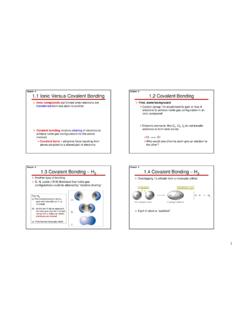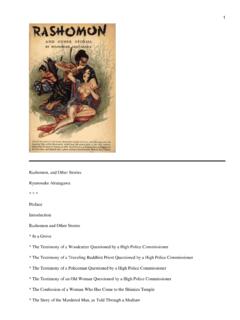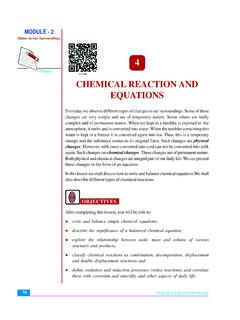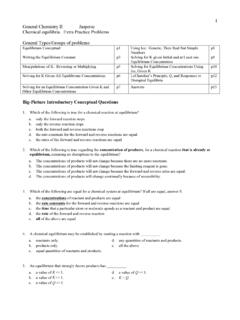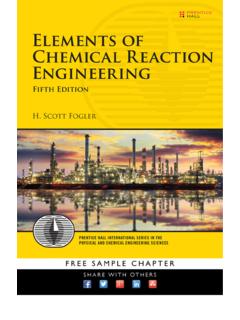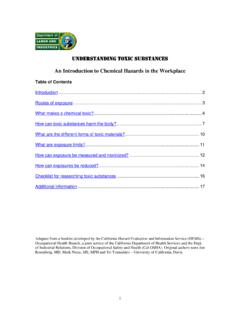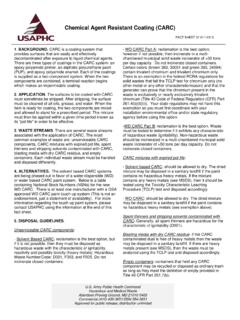Transcription of Chapter 4 Moles and Chemical Reactions Stoichiometry
1 1 Moles and Chemical Reactions We have used the mole concept to calculate mass relationships in Chemical formulas Molar mass of ethanol (C2H5OH)? Mass percentage of carbon in ethanol? Chapter 4 Molar mass = 2 x + 6 x + 1 g/mol % C = 2 x x 100 % % Stoichiometry We can also use the mole concept to calculate mass relationships in Chemical Reactions Stoichiometryis the study of mass relationships It requires a balanced equation The coefficientsin a balanced Chemical equation represents how many molesof one reactant are needed to react with other reactants. It also shows how many Moles of product will be formed. Chemical equation relates molesof reactants to molesof products The equation DOES NOTdirectlyrelate the masses of reactants and productsChapter 4 Consider the reaction3 H2 + N2 2 NH3 Balanced? Coefficients in a balanced equation number of molesMoles and Chemical ReactionsChapter 43 H2 + N2 2 NH33 molecules2 molecules1 molecules3( ) ( ) molecules3 moles1 mole2 moles300 molecules 100 molecules 200 molecules The coefficients in a balanced Chemical equation can be used to relate the number of Moles of each substance involved in a ratiosmol reactantmol reactantmol productmol reactant mol product mol productMoles and Chemical ReactionsChapter 42 3 different molar ratios can be written (why 3?)
2 1 mol N21 mol N23 mol H23 mol H22 mol NH32 mole NH3 For the reaction:N2 + 3 H2 2 NH3 Moles and Chemical ReactionsChapter 4 MOLAR RATIOS = CONVERSION FACTORS If you have mole of H2, how many Moles of NH3can you produce?N2 + 3 H2 2 NH3 Note:Make sure your equation is balanced!Given: mol H2 Find: mol NH3 Conversion factor:molar ratioMoles and Chemical ReactionsChapter 4# mol NH3= mol H2x 2 mol NH33 mole H2= mol NH3 Moles and Chemical ReactionsChapter 4 If you have mole of H2, how many Moles of N2will be required to completely react all of the H2?N2 + 3 H2 2 NH3 Given: 1 mol H2 Find: mol N2 Conversion factor:molar ratioMoles and Chemical ReactionsChapter 43# Moles N2= mol H2x 1 mol N23 mol H2= mol N2 Moles and Chemical ReactionsChapter 4 How many Moles of N2are needed to produce Moles of NH3?N2 + 3 H2 2 NH3 Given: mol NH3 Find: mol N2 Conversion factor:molar ratioMoles and Chemical ReactionsChapter 4# mol N2= mol NH3x 1 mol N22 mol NH3= mol N2 Moles and Chemical ReactionsChapter 4 From a balanced Chemical equation we get the number of Moles of reactants and products BUT We don t measure out Moles in the lab!
3 Chemists use a balance to measure the mass of a substance used or produced in a reaction. How can you determine the mass of reactants or products? Moles and Chemical ReactionsChapter 44 Use the molar massto convert from Moles to grams The numberof grams of a substance per moleMass (g) Compound AMoles Compound AMoles Compound BMass (g) Compound BMolarmassMolarmassMolar ratioXMoles and Chemical ReactionsChapter 4 Stoichiometry For the following reaction:N2(g) + 3 H2(g) 2 NH3(g) How many grams of NH3 would form if Moles of N2reacted with excess H2? Chapter 4 Given: mol N2 Find: g NH3 Conversion factors:molar ratio, molar massg NH3= mol N2 x 2 mol NH3x NH31 mol N2 1 mol NH3= g NH3 How many grams of N2are required to react completely with grams of H2?N2(g) + 3 H2(g) 2 NH3(g)StoichiometryChapter 4 Given: H2 Find: g N2 Conversion factors:molar mass ,molar ratiog N2= g H2 x 1 mol H2x 1 mol N2x g H23 mol H2 1 mol N2= g N2 StoichiometryCH4 + 2 O2 CO2+ 2 H2O Answer the following questions: How many Moles of O2are required to react with Moles of CH4?
4 How many grams of H2O will form when Moles of CH4react with excess O2? How many grams of O2must react with excess CH4to produce grams of CO2? Chapter 45 Stoichiometry Metallic iron reacts with oxygen to form iron(III) oxide Balanced eqn: Calculate the grams of iron needed to produce g of 44 Fe + 3 O2 2 Fe2O3 Given: g Fe2O3 Find: g FeConversion factors:molar massesmolar ratioStoichiometryChapter 4 Strategy:grams Fe2O3moles Fe2O3grams Fe Moles FeStoichiometryChapter 4molar massmolar massmolar ratiog Fe= g Fe2O3x 1 mol g g Fe1 mol Fex 4 mol Fe2 mol Fe2O3= g FeMolar Mass of Fe2O3= 2 ( g/mole) + 3 ( g/mole) = g Fe2O3/moleStoichiometryChapter 4x4 Fe + 3 O2 2 Fe2O36 Stoichiometry The steel industry relies on the reaction between iron(III) oxide and carbon to produce iron and 3C 4Fe + 3CO2 What mass of iron can be obtained from 454 g of iron(III) oxide? What mass of carbon is required to react with 454 g of iron(III) oxide?
5 Chapter 4 Stoichiometry Ethane (C2H6) burns in oxygen to form CO2and water2C2H6+ 7O2 4CO2 + 6H2O What mass of ethane is required to produce 100. g of water? What mass of CO2is formed along with the 100. g of water? Chapter 4 Making Turkey Sandwiches Suppose you were going to make turkey sandwiches:+++2 slices bread + 1 slice cheese + 1 slice turkey 1 sandwichChapter 4 You have 8 slices of bread and 20 slices of turkey and 20 slices of cheese. How many sandwiches you can make using the above recipe? You have 4 slices of cheese and 20 slices of turkey and 20 slices of bread. How many sandwiches you can make using the above recipe? Limiting reactant?We can only make 4 sandwiches because we don t have enough bread!Bread = limiting reagent or limiting reactantChapter 4 Making Turkey Sandwiches2 slices bread + 1 slice cheese + 1 slice turkey 1 sandwich7 Limiting Reactants Similar situations occur in Chemical Reactions when one of the reactants is used up before the others.
6 No further reaction can occur The excess reactant(s) are leftovers. Chapter 42 H2(g) + O2(g) 2 H2O (l)If we react 10 Moles of H2with 7 Moles of O2, not all of the O2will react because we will run out of H2first!Limiting ReactantsChapter 4 For 10 Moles of H2 we need only 5 Moles of O2! Limiting reactant: the reactant that is completely consumed in a reaction determines or limits the amount of product ReactantsChapter 4 To determine which reactant is the limiting reagent: Compare the number of Moles of each reactant needed with the number of Moles of each reactant available Calculate the number of grams of product that each reactant could form Reactant that forms the least amount of product will be the limiting ReactantsChapter 42 H2(g) + O2(g) 2 H2O (l)8 If grams of H2are mixed with grams of O2, which reactant is the limiting reagent?2 H2(g) + O2(g) 2 H2O (l)Limiting ReactantsChapter 4 Step 1: Convert mass to molesMoles H2= g H2 x 1 mole= mol H2 gMoles O2= g O2x 1 mole= mol O2 gMethod 1 Limiting ReactantsChapter 4moles O2needed = mol H2x 1 mol O22 mol H2= Moles O2 Step 2 Pick H2 and find the Moles O2needed to react with all of the H2 Limiting ReactantsChapter 4 Step 3 Compare the # Moles O2needed to # Moles = Moles O2O2available = Moles O2 Less O2is available than we need to react with all of the H2.
7 O2will run out first. Therefore, O2is the limiting reagent. Limiting ReactantsChapter 49 Method 2 Step 1: Calculate the amount of product each reactant could H2O from H2= g H2x 1 mol H2x 2 mol g H22 mol H2x g H2O = g H2O1 mol H2 OLimiting ReactantsChapter 4g H2O from O2= g O2x 1 mol O2x 2 mol g O21 mol O2x g H2O = g H2O1 mol H2 OLimiting ReactantsChapter 4 Limiting reagent is the one that produces the least g H2could produce g g O2could produce g H2OO2is the limiting reagent Suppose we have a mixture of g of CH4and grams of O2. Which is the limiting reactant?CH4 + 2 O2 CO2+ 2 H2 OThe Limiting ReactantChapter 4CH4 + 2 O2 CO2+ 2 H2O Now suppose that the grams of CH4reacts with the grams of O2. What mass of the unused reactant is left over when all the CH4has been consumed?The Limiting ReactantChapter 410H2 + C CH4 Suppose that g of H2reacts with g of carbon Which reactant is limiting? What mass of CH4could form when combining these reactants?
8 How much of the unused reactant is left over?The Limiting ReactantChapter 4 Reaction Yield We have been calculating how much product would form for various Chemical Reactions The amount we calculate is usually higher than what we would obtain in lab This is not a violation of the law of conservation of matter Why are the two values different? Chapter 4 Often, the actual yield is less than the theoretical yield: reactants may not react the reaction does not go to completion by-products may formunwanted side Reactions (competing Reactions ) difficulty isolating and purifying the desired productReaction YieldChapter 4 Reaction Yield The mass of product obtained in the reaction is the actual yield The maximum amount possible, calculated from the limiting reagent principle, is the theoretical yield The percentage yieldis defined as:Actual yieldTheoretical yieldx 100 = percentage yieldChapter 411 Reaction Yield A chemist isolates g of product from a reaction that has a calculated theoretical yield of g.
9 What is the percentage yield? Chapter 4 Reaction Yield Lime (CaO) is produced by heating CaCO3 according to the following equation:CaCO3(s) CaO(s) + CO2(g) Suppose we heat 510 grams of CaCO3and isolate 235 grams of CaO. What is the percentage yield? Chapter 4

